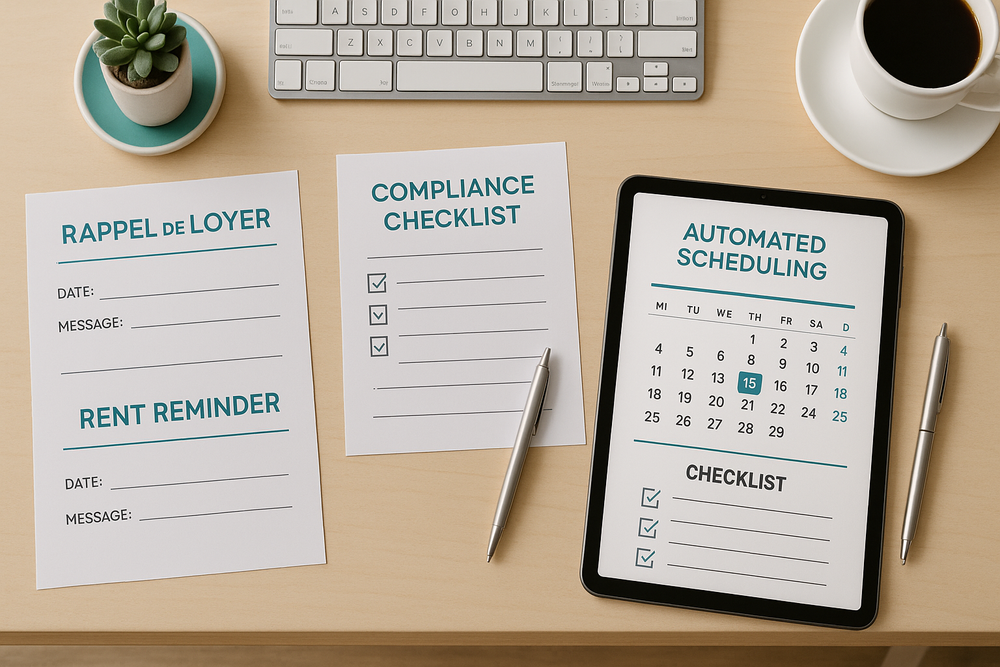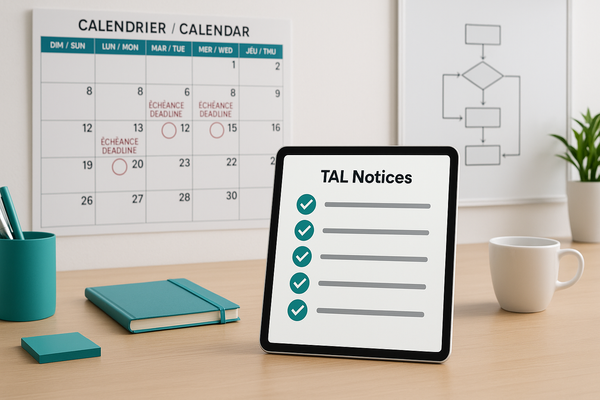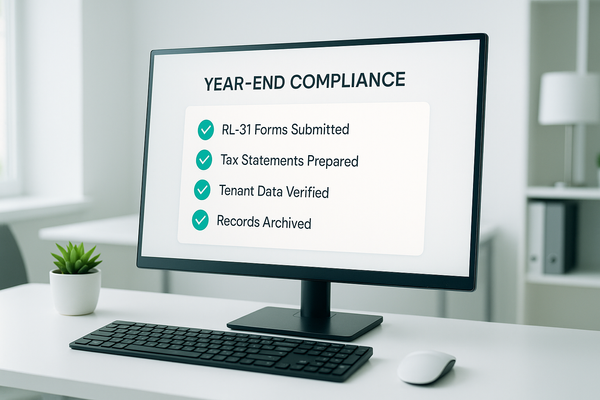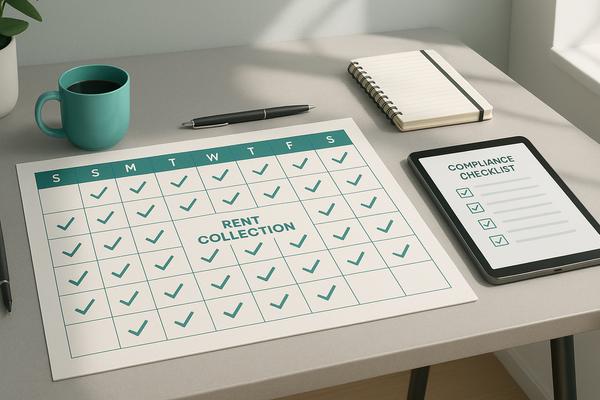Stop Chasing Rent: Automate Your TAL-Compliant Rent Reminder in Québec
How to Boost Cash Flow, Stay Legal, and Eliminate Admin Headaches with Automation
Missed or late rent payments can quickly become your biggest headache, especially when juggling Québec’s strict TAL compliance and bilingual communication requirements. If you’re still manually sending rent reminders, you’re not only wasting time—you’re exposing your business to costly errors, compliance risks, and strained tenant relations that slow your growth.
Managing rent reminders in Québec under TAL rules feels like navigating a legal maze, but with the right approach, you can turn it into a streamlined, time-saving process. In this article, you’ll get practical, legally compliant bilingual rent reminder templates and automation tips tailored to Québec’s unique requirements. These strategies will help you simplify workflows, protect your business, and improve your cash flow—all while freeing up your team to focus on scaling your portfolio.
Let’s break down how automating your rent reminder process can take the stress out of chasing rent, ensure TAL compliance, and make your property management operation more efficient and profitable.
The Challenge of Managing Rent Reminders under Québec’s TAL Rules
Understanding the Complexity of TAL Compliance
In Québec, rent reminders are governed by strict regulations from the Tribunal administratif du logement (TAL). This legal landscape mandates that all rent notices adhere to specific language, timing, and content standards to be legally enforceable. This is a significant operational hurdle; a survey detailed in '75+ Property Management Statistics: Digital Revolution (2025)' found that around 60% of property managers report compliance regulations have increased their workload. A rent reminder in Québec must be clear, respectful, and legally sound to avoid disputes.
A key requirement is that notices must be bilingual—in both French and English—to serve the region’s linguistic obligations. This isn’t a courtesy but a legal necessity to guarantee tenants fully understand the message. Additionally, the timelines for sending reminders are strictly defined. Generally, a landlord must send a reminder before the due date or within a specific window afterward, depending on the lease.
Common pitfalls include sending notices that are too early, too late, or not bilingual, which can invalidate the notice and complicate enforcement. Failing to follow these rules exposes property managers to legal risks and tenant disputes that may escalate to TAL hearings.
Operational Impact of Manual Rent Reminder Processes
Managing rent reminders manually hinders operational efficiency. Tracking due dates, drafting bilingual notices, and ensuring timely dispatch consumes substantial staff time—time better spent on tenant relations or property improvements. This is a widespread issue; a report from the NAA notes that "overall, 69% of leadership and 55% of staff wish they had more time to focus on higher-level tasks" (Source: 'The Intelligence of AI’s Time-Saving Benefits').
When reminders are sent late or missed, rent collection suffers and directly impacts cash flow. This is a significant pain point, with one report finding that 41% of property managers cite late rent payments as a top challenge (Source: '75+ Property Management Statistics: Digital Revolution (2025)'). This manual workload often results in errors like typos or inconsistent messaging, which can cause tenant confusion, delay payments, and risk non-compliance with TAL obligations. Furthermore, the repetitive nature of manual reminders increases staff burnout, and the risk of human error grows with your portfolio.
Financial and Legal Consequences of Non-Compliance
Non-compliance with TAL rent reminder rules can have serious financial and legal repercussions. Incorrect, incomplete, or untimely notices may give tenants grounds to dispute charges or refuse payment, leading to prolonged legal battles. These disputes delay rent collection and damage landlord-tenant relationships.
Legally, failure to provide TAL-compliant notices may result in fines or sanctions. In some cases, repeated infractions could lead to significant penalties or complicate future proceedings. Adopting process automation for rent collection—especially specialized workflow solutions that generate compliant notices automatically—ensures consistent adherence to legal deadlines and language requirements, protecting your business.
Automation as the Solution: Streamlining TAL-Compliant Rent Reminders
The Benefits of Automating Rent Reminders
Implementing automation for rent collection in Québec can dramatically transform how you handle tenant communications. With automation, you save valuable time by eliminating the repetitive tasks of drafting, translating, and sending notices.
- Ensure TAL Compliance: Automation is key to consistently adhering to TAL timelines and bilingual requirements. Well-designed tools can automatically trigger bilingual rent reminder templates based on legal deadlines, ensuring notices are sent exactly when required by law in both French and English.
- Reduce Human Error: Manual reminders are prone to mistakes—missed deadlines, translation errors, or inconsistent messaging—that expose your business to TAL infractions. Automated systems safeguard against these risks by standardizing every notice.
- Improve Cash Flow: Timely, professional reminders prompt quicker payments. When reminders are sent consistently, late payments decrease, and you maintain more predictable revenue. This isn't just theory; as reported by 'Workflow Automation Statistics & Trends For 2024', organizations already implementing automation report an average cost reduction of 24%.
Key Features of an Effective Automation Tool
To maximize benefits, your automation tool should be tailored to Québec’s specific legal landscape.
- Built-in Bilingual Templates: Look for solutions offering templates compliant with Québec’s regulatory framework. These should incorporate TAL-required language and be easily customizable.
- Flexible Scheduling: Your system must automatically trigger reminders according to TAL notice periods—whether that’s 5 days prior to the due date or at specific intervals if rent is overdue.
- Seamless Integration: The tool should connect with your existing property management software to sync data and reduce manual entry. Research confirms that
[automating repetitive tasks is a primary driver for PropTech adoption](https://www.nar.realtor/commercial/create/proptech-insights-from-property-managers), making this a critical consideration. - Audit Trails: Look for solutions that log all communications. Clear records of when reminders were sent, in what language, and via which channel help you verify compliance if ever challenged.
How to Implement Bilingual, TAL-Compliant Rent Reminder Automation
Step 1: Adopt Ready-to-Use Bilingual Templates
The foundation of effective automation is starting with comprehensive, legally sound templates. These must include key components in both French and English, such as property address, tenant information, amount owed, and TAL-compliant instructions. A proper TAL rent reminder template should cover various scenarios: an initial friendly reminder, a formal late payment notice, and follow-up notices, all while maintaining a professional tone.
Step 2: Set Up Automated Scheduling Aligned with TAL Timelines
Timing is critical. Automate your reminders based on lease dates and legal notice periods. For instance, schedule an initial reminder to be sent 5 days before rent is due and a follow-up if payment isn't received. Your system should be flexible enough to handle different lease cycles and allow you to segment tenants by language preference so reminders are automatically sent in French, English, or both.
Step 3: Integrate Automation with Your Property Management System
Seamless integration is key to avoiding data entry errors. Your rent reminder automation should connect directly with your property management or rent collection platform. This kind of integration is a core component of [a modern property manager's tech strategy](https://s3-us-east-2.amazonaws.com/jpmonline/wp-media-folder-jpm/wp-content/uploads/2024/02/JPM-Mar-Apr-24-Final-View.pdf), ensuring all systems work together. When a payment is missed, your system can automatically send a late rent notice using your Québec rent notice template without any manual intervention.
Step 4: Train Your Team and Communicate with Tenants
Transitioning to automation requires clear communication. Train your team on how the new system works, emphasizing compliance and professional tenant interactions. Inform tenants about the new process, explaining that automated reminders are designed to help them avoid late fees and ensure clear, consistent communication. This transparency builds trust and reduces the likelihood of disputes.
Best Practices to Maximize the Impact of Automated Rent Reminders
Maintain Compliance and Enhance Tenant Relations
Automation doesn’t mean sacrificing the personal touch. To ensure your process is both compliant and effective, focus on these best practices:
- Use Legally Vetted Templates: Start with fully bilingual templates crafted in accordance with Québec’s rental laws. To minimize legal risks, choose templates created or reviewed by experts familiar with Québec’s landlord-tenant legislation.
- Stay Up-to-Date: The legal landscape evolves. Regularly review updates from the TAL and incorporate changes into your templates and workflows. Schedule periodic audits to verify your reminders are correctly timed and worded.
- Personalize Communication: Use automation to personalize messages with tenant names and specific details. This fosters respect and improves cooperation, turning a routine notice into a positive touchpoint that strengthens tenant satisfaction.
Monitor Performance and Drive Continuous Improvement
To refine your strategy, you need to measure what matters. This aligns with industry best practices, such as [centralizing functions to enhance efficiency](https://www.multihousingnews.com/irem-special-report-operational-best-practices-for-a-future-proof-business/) and leveraging technology for better outcomes.
- Track Key Metrics: Monitor KPIs such as the reduction in late payments, average collection time, and administrative hours saved. This data helps justify the investment and demonstrates ROI.
- Create a Feedback Loop: Use tenant response rates and feedback to adjust your messaging, timing, or communication channels. Continuous refinement ensures your automated reminders are not only compliant but also highly effective.
- Choose the Right Partner: Select an automation partner with proven experience in Québec’s rental market. A vendor with tailored solutions that respect the regional legal landscape makes implementation straightforward and guarantees your workflows align perfectly with local regulations.
Your Path to Property Management Efficiency
Ultimately, managing rent reminders in Québec is less about chasing payments and more about mastering a complex legal process without sacrificing efficiency. By swapping manual, error-prone reminders for smart, TAL-compliant automation, you transform a high-stress administrative burden into a reliable operational asset. This strategic shift not only guarantees bilingual compliance and improves cash flow, but it also liberates your team to focus on high-value activities like strengthening tenant relationships and scaling your property portfolio.
Drowning in repetitive admin tasks? Discover how WorkflowLeaf can automate the busywork so you can focus on growth. Schedule your workflow review. Schedule your workflow review.
Frequently Asked Questions
How do I send a TAL-compliant rent reminder in Québec?
To send a TAL-compliant rent reminder in Québec, use bilingual notices (French and English) that include the tenant’s details, rent amount, due date, and clear payment instructions. Ensure the notice follows TAL-mandated timelines and contains legally required language to avoid disputes or penalties. Automating this process with pre-approved bilingual templates helps maintain compliance consistently.What is the proper notice period for sending rent reminders under Québec’s TAL rules?
Québec’s TAL rules require rent reminders to be sent either before the rent due date—commonly 5 days prior—or within specific periods after a payment is missed. Automation tools can be set up to trigger reminders exactly within these timelines, ensuring you meet legal deadlines and avoid sending notices that are too early or too late.Can I automate bilingual rent reminders in Québec to improve efficiency?
Yes, automating bilingual rent reminders in Québec is highly effective. Automation eliminates manual drafting and translation, ensures reminders are sent on schedule per TAL rules, reduces human errors, and improves tenant communication consistency—all while saving staff time and reducing burnout.What features should I look for in rent reminder automation software for Québec?
Look for tools offering legally vetted bilingual templates, TAL-aligned scheduling that triggers notices before or after rent due dates, seamless integration with your property management system to track payments in real time, and comprehensive audit trails to document communications. These features ensure compliance, efficiency, and transparency.How do I implement and communicate a new automated rent reminder system to my team and tenants?
Start by adopting ready-to-use bilingual TAL-compliant templates and set up automatic schedules aligned with legal timelines. Train your staff on using the system and its compliance importance. Inform tenants about the switch, explaining that reminders are automatic, bilingual, and intended to support timely payments, which helps build trust and reduces disputes.
Note: Always verify with your legal counsel or the TAL website to ensure your rent reminder process meets current Québec regulations.



